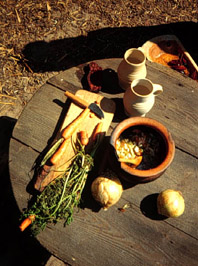Meet the Middle Ages
BackFood

Medieval food varied a lot depending on whether it was an ordinary working day or a holiday and also whether you were rich or poor. On an ordinary day, a craftsman’s family had porridge and bread for breakfast and cabbage soup or a root vegetable stew with bread and salted herring for dinner. To drink, they had the town ´s beer or water. During the fast, people were not allowed to eat large dinners or meat. Instead, they ate fish. Every Friday was a fast day. Before Easter and Christmas, there was a long period of fasting. More than half of the days of the year were fast days. The day after a long period of fast was celebrated, for example Easter Sunday and Christmas Day.
Having a feast meant that lots of food was served. There would be many dishes, perhaps ten or fifteen. In the Middle Ages, foreign spices, like pepper, cinnamon, clove, ginger or saffron were used in the food. At a feast held by the Town Guild or on Easter Sunday, the meal could consist of onion soup, rye bread, cold meats (sausage, black-pudding) and boiled pike or ling, meat, vegetable stew and stewed fruit. All this was washed down with German beer or French wine.
Most town-dwellers had small plots, cabbage gardens, on the outskirts of the town. There, they grew their vegetables and root vegetables. Some of them also kept hens and a pig. But this was not enough to feed a family. Once a week, the women went to the market-place to buy necessary things, for example flour, butter, cheese and meat. In the convent garden, nice fruits, such as apples or pears, were grown.
It was easier to find good-quality food and spices in town than in the country-side. Nevertheless, there would be a lack of food at certain times of year since the city-dwellers themselves did not grow many vegetables.
The food was salted or dried so that it would keep all winter. In spring and in autumn, the salt ships came to town from Lübeck or from some other German town.In the following pages, you can find recipes for medieval food.
Read more about food under "Country Life. Workdays and Holidays."